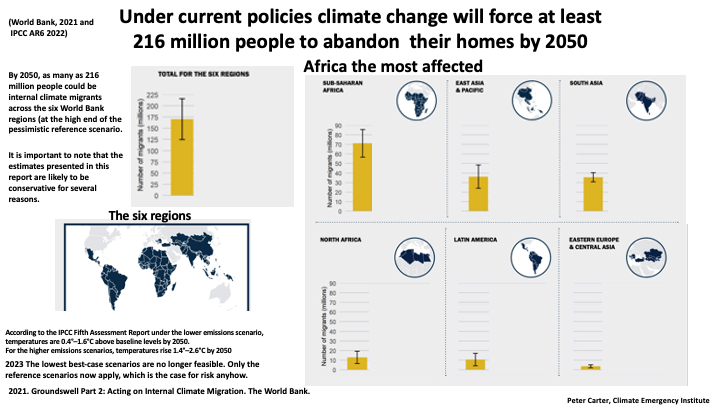Refugees
Other online resources
Oct 2019 UNICEF State of the World Children Food & Nutrition: 149 million
children aged under 5 still suffer from stunting and almost 50 million
from wasting; 340 million children suffer from the hidden hunger of
deficiencies of vitamins and minerals. Climate change features.
21 June 2018 World Bank, S, Hallegatte 20 million people will be forced into poverty through climate change in 2030. 100 million people if no speedy action
children aged under 5 still suffer from stunting and almost 50 million
from wasting; 340 million children suffer from the hidden hunger of
deficiencies of vitamins and minerals. Climate change features.
21 June 2018 World Bank, S, Hallegatte 20 million people will be forced into poverty through climate change in 2030. 100 million people if no speedy action
UNICEF 2017 'Climate change is contributing to a growing water crisis and putting the lives of millions of children at risk'. 'By 2040 1 in 4 children are projected to be living in areas of extremely high water stress'
18 Feb. 2020 A future for the world’s children? WHO–UNICEF–Lancet Commission
Recent trends
Children are likely to suffer abandonment
At the end of 2019, around 5.1 million people in 95 countries and territories were living in displacement as a result of disasters that happened not only in 2019, but also in previous years. (IDMC, 2020).
The countries with the highest number of internally displaced persons were Afghanistan (1.2 million); India (590,000); Ethiopia (390,000), Philippines (364,000) and Sudan (272,000) (ibid.).
The countries with the highest number of internally displaced persons were Afghanistan (1.2 million); India (590,000); Ethiopia (390,000), Philippines (364,000) and Sudan (272,000) (ibid.).
In 2019, nearly 2,000 disasters triggered 24.9 million new internal displacements across 140 countries and territories; this is the highest figure recorded since 2012 and three times the number of displacements caused by conflict and violence (ibid.)
Most of the disaster displacements were the result of tropical storms and monsoon rains in South Asia and East Asia and Pacific; four countries accounted for more than 17 million new internal displacements due to disaster: India (5 million), the Philippines (4.1 million), Bangladesh (4.1 million), and China (4 million) (ibid.)
Most of the disaster displacements were the result of tropical storms and monsoon rains in South Asia and East Asia and Pacific; four countries accounted for more than 17 million new internal displacements due to disaster: India (5 million), the Philippines (4.1 million), Bangladesh (4.1 million), and China (4 million) (ibid.)
While the majority of mobility in the context of environmental and climate change more generally, including disaster displacement, occurs within the borders of countries, some people are forced to move abroad.
Global data on cross-border movement in the context of disasters are, however, limited, with only a few notable cases being examined so far (Nansen Initiative, 2015; Ionesco, Mokhnacheva and Gemenne, 2017). In some cases, official sources on humanitarian visas by countries such as the United States (US), Brazil and Argentina for Haitians can be used.
Global data on cross-border movement in the context of disasters are, however, limited, with only a few notable cases being examined so far (Nansen Initiative, 2015; Ionesco, Mokhnacheva and Gemenne, 2017). In some cases, official sources on humanitarian visas by countries such as the United States (US), Brazil and Argentina for Haitians can be used.
Slow-onset processes such as droughts or sea level rise also increasingly affect people’s mobility worldwide.
Though specific data are not available, case studies are highlighted by existing research, for example: Foresight, 2011; Piguet and Laczko, 2014; Ionesco, Mokhnacheva and Gemenne, 2017.
Though specific data are not available, case studies are highlighted by existing research, for example: Foresight, 2011; Piguet and Laczko, 2014; Ionesco, Mokhnacheva and Gemenne, 2017.
The relocation of communities in the context of environmental and climate change is also increasingly implemented by governments (for a summary of recent relocation programmes see Ionesco, Mokhnacheva and Gemenne, 2016; Benton, 2017 and Georgetown University, UNHCR and IOM, 2017).
For instance, tens of thousands of people have been relocated in Haiti (Pierre, 2015) and in Viet Nam (UN Viet Nam, 2014; Chun 2014; Entzinger and Scholten, 2015); hundreds of thousands in Ethiopia (Foresight, 2011: 177); about a million in the Philippines (Ranque and Quetulio-Navarra, 2015; Thomas, 2015; Brookings and UNHCR, 2015: 3-4) and several millions in China (Foresight, 2011)
For instance, tens of thousands of people have been relocated in Haiti (Pierre, 2015) and in Viet Nam (UN Viet Nam, 2014; Chun 2014; Entzinger and Scholten, 2015); hundreds of thousands in Ethiopia (Foresight, 2011: 177); about a million in the Philippines (Ranque and Quetulio-Navarra, 2015; Thomas, 2015; Brookings and UNHCR, 2015: 3-4) and several millions in China (Foresight, 2011)
Children are likely to suffer abandonment

Climate Emergency Institute
The latest 2021 World Bank Groundswell report estimates that 216 million people could be forced to move within their countries by 2050 due to slow-onset events across six regions. Other scenarios have varied to as many as 1 billion people displaced by climate change during the same period of time.

13 September 2021, World Bank , Millions on the Move in Their Own Countries:
The Human Face of Climate Change
The Human Face of Climate Change
New Groundswell report projects that 216 million people in six regions could move within their countries by 2050.
he report includes new projections from three regions: East Asia and the Pacific, orth Africa, and Eastern Europe and Central Asia.
The report includes new projections from three regions, East Asia and the Pacific, North Africa, and Eastern Europe and Central Asia. It builds on the first Groundswell report from 2018, which covered Sub-Saharan Africa, South Asia and Latin America. Taken together, projections across all the regions out to 2050 find that: Sub-Saharan Africa could see as many as 86 million internal climate migrants; East Asia and the Pacific, 49 million; South Asia, 40 million; North Africa, 19 million; Latin America, 17 million; and Eastern Europe and Central Asia, 5 million.
he report includes new projections from three regions: East Asia and the Pacific, orth Africa, and Eastern Europe and Central Asia.
Early and concerted action to cut global greenhouse gas emissions and to ensure inclusive and resilient development can reduce the scale of internal climate migration by as much as 80%.
The report includes new projections from three regions, East Asia and the Pacific, North Africa, and Eastern Europe and Central Asia. It builds on the first Groundswell report from 2018, which covered Sub-Saharan Africa, South Asia and Latin America. Taken together, projections across all the regions out to 2050 find that: Sub-Saharan Africa could see as many as 86 million internal climate migrants; East Asia and the Pacific, 49 million; South Asia, 40 million; North Africa, 19 million; Latin America, 17 million; and Eastern Europe and Central Asia, 5 million.
Internal climate migration is projected to grow for the next several decades and then accelerate through the second half of this century if countries do not reduce global greenhouse gas emissions and build resilience to current and future climate change impacts. So-called ‘hotspots’ of climate migration emerge within countries as early as 2030: with climate out-migration occurring in areas where livelihoods are threatened by climate change, and climate in-migration in areas with better livelihood opportunities.

Children are the worst effected